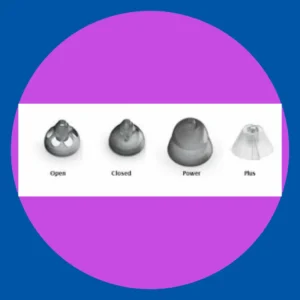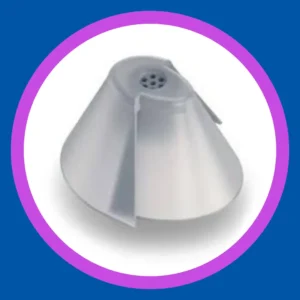Selecting the Best Hearing Aid Domes
Your hearing aid domes can make or break your experience with hearing aids. If you’re searching for better comfort, clearer sound, and less feedback, finding the best hearing aid domes is key. These small silicone pieces sit inside your ear canal and direct sound from the receiver into your ear. Their size, shape, and style can greatly impact how well your hearing aids work.
Let’s explore how dome types, fit, and features can help you hear your best.
Why Hearing Aid Domes Matter
Hearing aid domes aren’t just accessories—they affect every part of your hearing experience.
Here’s why they matter so much:
- They control how sound reaches your eardrum.
- They determine how much outside noise you hear.
- They influence feedback and how your own voice sounds.
- They affect comfort during all-day wear.
Getting the right dome can improve your sound clarity, speech understanding, and overall satisfaction with your devices.
Worried about hearing aid fit? Explore custom hearing aids.

The Three Main Types of Hearing Aid Domes
Each dome type suits different hearing needs. Let’s explore the most common dome options.
1. Open Domes
Open domes have multiple vents that let natural sound flow through the ear canal.
Best for: Mild hearing loss or when you want to hear background sounds naturally.
Pros:
- Reduces the plugged-up feeling.
- Makes your voice sound natural.
- Improves environmental awareness.
Cons:
- Higher risk of whistling or feedback.
- Less suitable for severe hearing loss.
Open domes are popular because they preserve natural sound, but they do sacrifice some amplification strength.
2. Closed Domes
Closed domes have fewer vents or none at all, creating a tighter seal in the ear.
Best for: Mild to moderate hearing loss when background noise needs reduction.
Pros:
- Blocks out external sounds.
- Amplifies low frequencies more effectively.
- Reduces feedback in noisy environments.
Cons:
- Can feel “plugged up.”
- Might distort your own voice.
Closed domes are a middle ground. They help you hear speech clearly while offering a balance between natural and amplified sound.
3. Power Domes
Power domes, or double domes, offer the most sealing and amplification.
Best for: Moderate to severe hearing loss needing maximum volume and minimal feedback.
Pros:
- Prevents feedback effectively.
- Delivers strong amplification.
- Creates a secure fit.
Cons:
- Most likely to feel occluded.
- Less natural sound from surroundings.
Use power domes if you need extra power and want your hearing aids to do all the work.

The Tulip Dome: A Versatile Hybrid
Tulip domes combine features of open and closed domes. They’re shaped like a flower with overlapping petals.
Best for: People needing a balance between openness and power.
Benefits:
- Offers better seal than open domes.
- More comfort than closed or power domes.
- Reduces wind noise and improves outdoor hearing.
Tulip domes work well for those with changing or moderate hearing needs.
Dome Size: Why It Matters
Size affects how the dome fits and sounds. Too large, and it feels tight. Too small, and it may fall out.
Signs your dome is too large:
- Discomfort or pressure in the ear.
- Difficulty inserting the hearing aid.
- A sore ear after wear.
Signs your dome is too small:
- Hearing aid feels loose.
- Sound leaks out, causing feedback.
- Reduced sound clarity.
Choose a snug but comfortable fit. Your hearing care provider can help select the ideal size for each ear.
Dome Materials and Comfort
Most domes are made from medical-grade silicone. This ensures durability, flexibility, and low allergy risk.
Comfort tips:
- Try softer domes if you have sensitive ears.
- Experiment with sizes and styles.
- If one ear feels different, you may need a different dome on each side.
How Domes Affect Sound Quality
Domes influence how sound travels and how natural it feels.
Open domes:
- Let low frequencies pass naturally.
- Provide a bright, airy listening experience.
Closed domes:
- Boost low-frequency amplification.
- Reduce environmental noise.
Power domes:
- Offer full-range sound amplification.
- Best for quiet voices or soft sounds.
The more occluded the dome, the more control your hearing aid has over the sound you hear.
Learn about the other sounds your ears could be making.
Dealing with Feedback
Feedback, or whistling, happens when sound leaks and re-enters the microphone.
How to reduce feedback:
- Use the correct size dome.
- Try power or tulip domes for a tighter seal.
- Avoid placing the dome too loosely in the ear.
Feedback isn’t just annoying—it signals a poor fit. Let your hearing care provider adjust your dome to prevent it.
Find out when you need more than dome adjustments; understand when you need hearing aid repair.
Maintenance Tips for Hearing Aid Domes
Proper care keeps domes clean and effective. Follow these do’s and don’ts:
Do:
- Clean domes with a soft, dry cloth daily.
- Replace domes every 6 to 8 weeks.
- Store your hearing aids safely when not in use.
Don’t:
- Use harsh chemicals or alcohol wipes.
- Submerge domes in water.
- Reuse damaged or hardened domes.
Clean domes reduce the risk of infections and keep sound quality high.
Should You Replace Domes Yourself?
Yes, you can replace domes at home. But be sure to:
- Match the dome type and size.
- Attach the new dome firmly to avoid it getting stuck in your ear.
- Ask for help if the dome doesn’t feel secure.
If you’re unsure, Stanford Hearing is happy to help with replacements.
Manufacturer Domes vs. Off-Brand
Always use the dome designed for your hearing aid model.
Why this matters:
- Off-brand domes may not fit securely.
- They can cause sound distortion or feedback.
- They may shorten the lifespan of your devices.
Stick with manufacturer-approved domes for the best performance.
Experimentation Is Normal
Finding the best hearing aid domes may take some trial and error. Your ears and hearing needs are unique.
Tips for success:
- Try multiple dome types under professional guidance.
- Assess comfort after a full day of wear.
- Recheck dome fit if your hearing changes.
Stanford Hearing will work with you until you find your perfect dome match.
Understand more about the importance of hearing aid fitting.

Get the Right Fit with Stanford Hearing
Your hearing aid domes play a vital role in how well you hear every day. From sound quality to comfort, dome style and fit make a big difference. Whether you need open domes for a natural feel, power domes for strong amplification, or tulip domes for balance, we can help.
Experiencing feedback or discomfort? Don’t guess. Schedule a fit check with a Stanford Hearing care provider. We’ll make sure your domes—and your hearing—are exactly where they should be.
Contact Stanford Hearing today to optimize your hearing experience. Let’s make sure your domes deliver their best.
